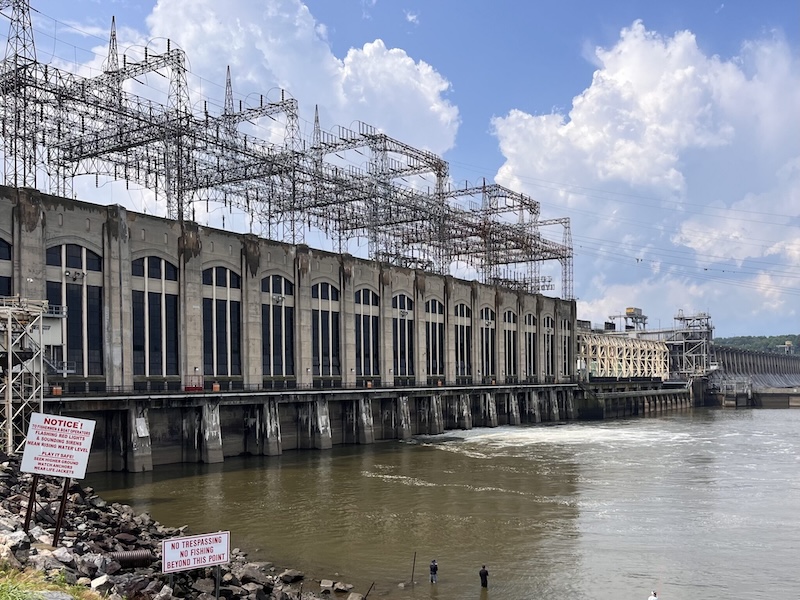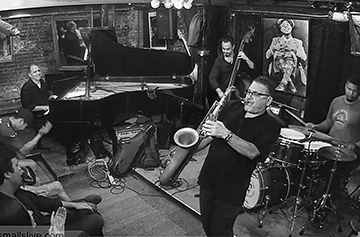Maryland officials unveiled a $340 million settlement Thursday and issued a new water quality certification to the Conowingo Dam, clearing the way for dam owner Constellation Energy to seek a new 50-year federal license to operate the hydroelectric facility.
The deal also resolves years of contentious litigation over the nearly century-old dam, which has become an environmental flashpoint in recent years as its overwhelmed reservoir has allowed polluting sediment to overflow into the Susquehanna River.
Particularly during severe storms, water overflowing from the Conowingo reservoir carries nutrients like nitrogen and phosphorus downstream, contributing to “dead zones” for underwater life in the Chesapeake Bay and hampering a struggling multistate effort to clean up the bay.
The settlement between Maryland, Constellation and a pair of clean water advocacy groups — Waterkeepers Chesapeake and the Lower Susquehanna Riverkeeper — includes $87.6 million for pollution reduction measures, including planting of trees and underwater grasses. It also includes more than $60 million to improve fish passage over the dam, control invasive species and create a hatchery for freshwater mussels to be planted in the river; and another $77.8 million to clean up trash and debris rushing down the Susquehanna.

The Conowingo Dam in Maryland is a 550-megawatt hydroelectric power station on the Susquehanna River operated by Constellation Energy.
Constellation will also pay $18.7 million to explore, and possibly begin, dredging at the dam’s reservoir. But any dredging is still a long way off. All parties are waiting for a U.S. Army Corps of Engineers study that will use computer modeling to assess the impacts of dredging on the reservoir and river downstream. Once that study is complete, likely in late 2026 or 2027, the Maryland Department of the Environment will decide how to use dredging payments that Constellation must make annually for 25 years.
Even then, the agency could move toward getting a dredging permit, could call for more studies — including evaluating the potentially lucrative reuse of silt dredged from behind the dam — or could designate Constellation’s dredging payments to other environmental projects if the Corps study indicates dredging is inadvisable.
Robin Broder, executive director of Waterkeepers Chesapeake, said Thursday that she feels confident dredging will happen eventually.
Lower Susquehanna Riverkeeper Ted Evgeniadis said his team believes dredging is an economic and viable option. Prior estimates, which found that dredging would cost Constellation “hundreds of millions of dollars every year for 50 years,” are no longer accurate, he said.
“Dredging is much different today than it was 10 years ago, 15 years ago, 20 years ago. There are new technologies today, whether it’s a hydraulic dredge or an ejection dredge,” Evgeniadis said. “All of these new things that have come up over the years are going to be looked at.”
A news conference Thursday at the foot of the dam — near where fishermen cast their lines and below scores of circling vultures and waterbirds — featured what one Constellation official said would usuallyt be considered “strange bedfellows”: Maryland state officials, leaders of environmental nonprofits and Constellation Energy CEO Joseph Dominguez.
Dominguez jokingly turned his pocket inside out Thursday, telling the crowd: “Yeah, this is costly for us. And yeah, I don’t have anything but lint left in my pockets on this one.”
“But I’m glad it’s resolved. I’m glad we can get up here and proudly say we’re doing all of this work,” said Dominguez, praising Gov. Wes Moore’s “steady hand” in the negotiations over the dam, which has 11 turbines, and can produce up to 572 megawatts of electricity, enough to power 165,000 homes.
The story goes back to 2018, when Maryland issued a water quality certification to the dam’s previous owner, Exelon. Constellation and its energy generation portfolio split from Exelon in 2022 to became a standalone business.
That certification would have required the company to mitigate the nutrient and sediment overflows, or make compensatory payments to the state that Exelon said could have totaled $172 million a year. That’s because the dam contributes an estimated 6 million pounds of nitrogen and 260,000 pounds of phosphorus to the bay each year, according to the Maryland Department of the Environment.
Exelon challenged Maryland’s certification in court, and eventually the two parties reached a closed-door deal in which Exelon accepted a number of environmental conditions and agreed to pay about $200 million over 5o years toward restoring the Susquehanna and easing fish passage over the dam. In turn, Maryland waived its authority to issue the water quality certification, to the ire of environmental groups.
That’s where a federal court said Maryland went wrong. In December 2022, the District of Columbia Circuit Court of Appeals invalidated the 50-year hydropower license issued by the Federal Energy Regulatory Commission because it said Maryland could not waive its authority to issue the certification.
That sent Maryland back to the negotiating table — now with Constellation and the two environmental groups, who had also challenged the original water quality certification as not going far enough to protect the ecosystem. This was happening just as Moore was taking office.
“We inherited a project that was mired in lawsuits, had frustrations on all sides, where the future of the largest source of renewable energy in our state was in question, while environmental impacts were being unchecked,” Moore said. “I had people who said to me — they had a lot of words — but it all could get summed up in basically a few simple sentences: Stay away from the Conowingo Dam, because that problem is just too difficult to solve.”
Moore’s new environment secretary at the time, Serena McIlwain, having just arrived from California’s Department of the Environment, had to quickly get up to speed on the Conowingo Dam, along with the state’s other environmental challenges.
“I was told that, well, everything kind of went wrong with the negotiations before we started. One was, we didn’t have the right people at the table,” McIlwain said. “And I said to my team, make sure the right people — the waterkeepers — are at the table.”
Maryland learned “hard lessons” from the court’s rejection of the previous settlement, said Maryland Attorney General Anthony Brown. This time, the state issued a revised version of the 2018 water quality certification, along with the settlement.
“The Department of the Environment will retain full power to enforce compliance with water quality standards — and that matters,” said Brown, who called the settlement a “historic victory” for Marylanders and the Chesapeake Bay.
Getting to the finish line was challenging. Brown said it took more than 30 mediation sessions. McIlwain said there were times when some of the parties were “ready to walk out the door.” Among the biggest sticking points was the dredging issue, said Adam Ortiz, a deputy secretary at the Maryland Department of the Environment.
“We could have given up months ago. We really could have,” McIlwain said. “But I knew I needed my job, and I said: ‘You guys are going to get back at that table, and I’ll bring more food. I don’t care. We’re going to get it done.’”
Constellation’s Dominguez bemoaned the long road the dam operator had to walk in order to get its critical new license from FERC.
“It shouldn’t have taken us 10 years to sort through all of the issues here, and that’s a bit disappointing,” he said. “But … the resolution to those permitting issues often requires people coming together who have different interests, that sometimes have conflicting interests, and bringing those folks together and making something good happen.”
By Christine Condon












